The 2015 MacBook Review
by Ryan Smith on April 14, 2015 10:15 AM ESTThe MacBook’s Retina Display: Pro Quality
One of the long-standing demands for Apple’s MacBook Air line has been for an IPS, Retina-density display for Apple’s light laptops. After introducing Retina-style displays on the MacBook Pro, iPad, iPhone, and iMac, the Air was the last product without a Retina display. However at the same time the Air was also simultaneously Apple’s entry-level laptop and their ultra-portable laptop, so adding a Retina display to the Air has always faced the needs of balancing cost and technical considerations against consumer demand.
As it turns out the Air isn’t getting a Retina display (at least not this year), but Apple is going all-in on the more premium MacBook, Retina display, integrated cover glass, and all. From a cost perspective this isn’t all that surprising, but from a technical perspective it means Apple has needed to address the technical cost of going Retina.
Starting from the top, the MacBook ships with a 12” IPS Retina display. The display’s native resolution is an uncommon 2304 x 1440, which is essentially a 16:10 version of the more common 16:9 1440p. With Apple essentially going pro on the MacBook, I’m happy to see a 16:10 display in what’s now Apple’s smallest notebook, increasing the effective size of the display while giving it a more squared design that increases the amount of vertical real-estate versus what a 16:9 display would offer.
The MacBook’s display ends up being 64.72in^2 in size, roughly 13% larger than the MacBook Air 11”. This comes despite the fact that the MacBook occupies a smaller overall footprint than the MBA 11”, showcasing how Apple has been able to increase the screen size while bringing down the overall laptop size. Some of this is ultimately due to geometry from the different aspect ratio, but also Apple has been able to reduce the size of the bezel surrounding the panel, making the panel a larger percentage of the total lid. The MacBook still isn’t something that most people would qualify as an ultra-thin bezel, but coming from the relatively thick MacBook Air it’s quite the change.
Given the display’s native resolution of 2304 x 1440 contained in a 12” panel, this puts the pixel density of the display at 226 PPI, which is virtually identical to the 226 PPI rMBP13 and 220 PPI rMBP15, giving it same density as Apple’s other Retina laptops. Functionally speaking I’d argue that users are going to have their heads a bit closer to the 12” MacBook than they would a larger rMBP, so the effective density is likely still in the rMBP’s favor, but in terms of construction they’re all very similar.
Meanwhile Apple isn’t going into too much detail on the panel other than its size and driving technology (IPS), but they did tell us that the pixels in this panel were designed to have a wider aperture to allow more light out, helping to offset the higher power costs of lighting a Retina display. To that end Apple says that the MacBook’s display is 30% more energy efficient than any other Mac notebook at an equivalent brightness. At this point we’re still trying to identify the panel supplier, as Apple’s tools have not been very forthcoming. A Sharp IGZO panel would traditionally be a good choice for such a power-constrained device, but it’s entirely possible Apple is going with long-time partner LG as well.
Though regardless of the supplier and aperture improvements, as we’ll see in our battery life benchmarks Apple is clearly still having to devote quite a bit of power towards lighting this screen. Thankfully for Apple however just as with the rMBPs, iPhone, and iPad, this is a one-off cost that they don’t have to pay in future generations.
Moving on, as a Retina display Apple offers a range of scaled (virtual) resolutions, with the MacBook’s default resolution serving as a HiDPI version of 1280 x 800. The fact that the scaled resolution is not exactly one-quarter of the display’s physical resolution is an unusual first for an Apple device, but considering the size of the display and power requirements, not to mention the similar PPIs to the rMBPs, I suspect 1280 x 800 scaled on a 2304 x 1440 display was a tradeoff. In any case even without perfect 2:1 scaling Retina-enabled applications look great, and now nearly 3 years after started on Retina in the OS X ecosystem, the number of applications without Retina support are thankfully miniscule.
As far as desktop performance goes, we haven’t found any major problems for the MacBook’s Intel HD Graphics 5300 GPU. Even with Core M’s power limits it doesn’t show any issues holding 60fps at the default virtual resolution of 1280 x 800, though I would not suggest going any higher unless it’s necessary.
Finally, let’s take a look at the MacBook’s display by the numbers. From a design perspective Apple is shipping a pro-quality display, but does the out of the box performance match up with Apple’s high standards?
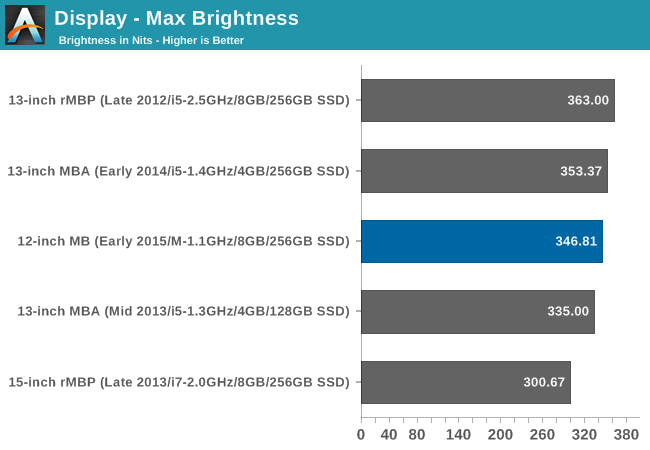
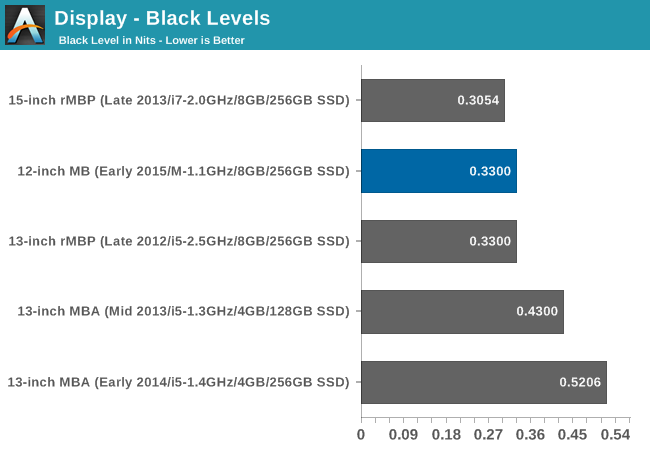
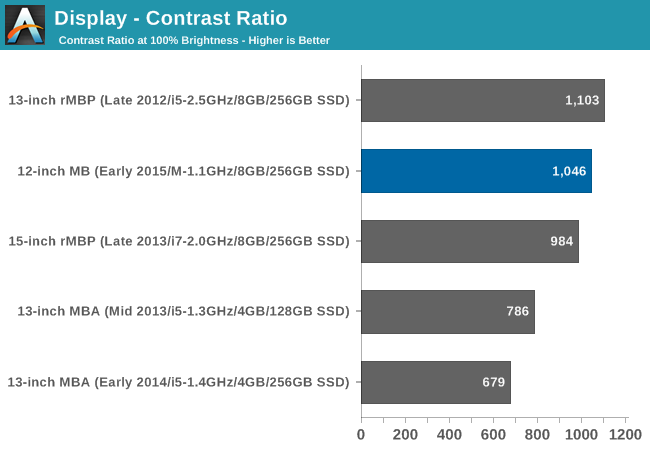
Compared to our most recent MacBooks, the 2015 MacBook delivers contrast performance similar to the Retina MacBook Pros, which is not all that surprising given the shared pixel densities and use of IPS panels among all of these products. Somewhat surprisingly, even with the MacBook’s more limited battery capacity Apple allows the max brightness to go up to 346 nits, in-line with the better-fed rMBPs. At this max brightness setting the black levels work out to 0.33, identical to the 2012 rMBP13. Overall Apple’s black levels tend to be better than average but not fantastic, and the MacBook doesn’t change this.
Otherwise this puts the final contrast ratio at 1046. This is fairly common for HiDPI IPS displays, and though it isn’t chart-topping it’s again right in line with what other Apple laptops do.
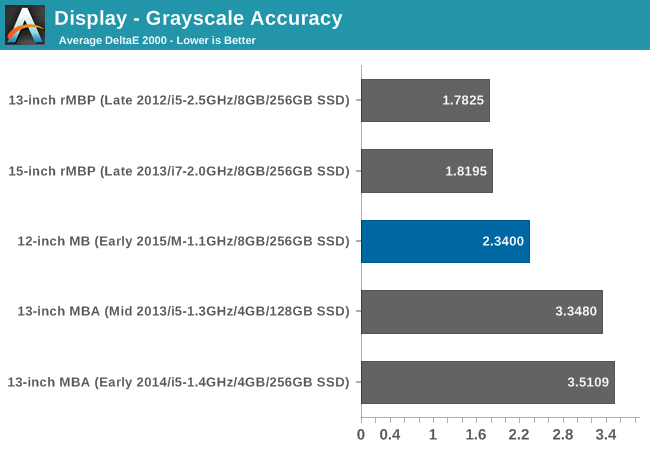
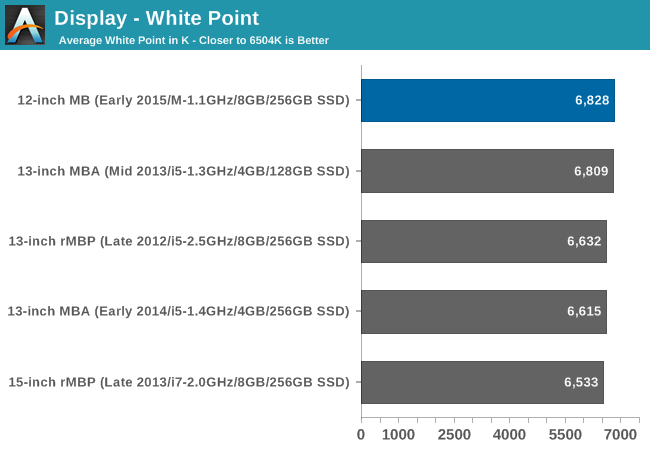
Moving on to accuracy measurements, the MacBook’s greyscale accuracy can’t quite touch the rMBPs, but otherwise at an error of just 2.34 it’s still among the best laptop displays. Even among great PC laptops, out of the box performance below 3 is exceptionally rare.
On the other hand the MacBook’s white point is not quite as good as we’d like to see, and not as good as what the rMBPs can do. The goal here is 6504; the MacBook hits 6828, reflecting the fact that it’s just a bit too red and just a bit too light on blue.
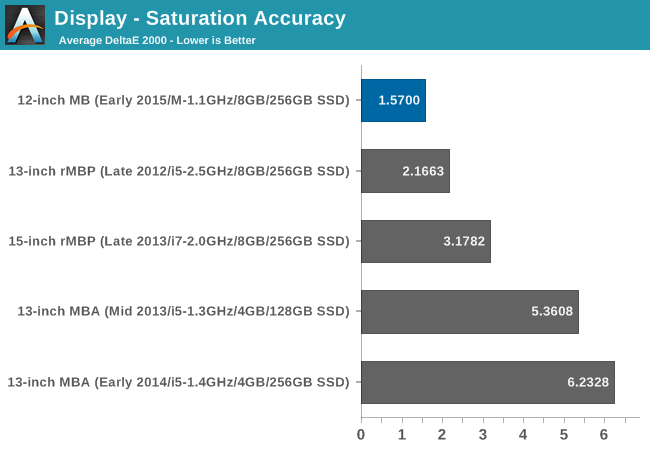
Meanwhile the MacBook’s color saturation accuracy is nothing short of amazing. Here it beats even the rMBPs, not to mention easily surpassing the MBAs and their TN displays. Even though it’s a bit too red, the MacBook is close enough for great out of the box performance.
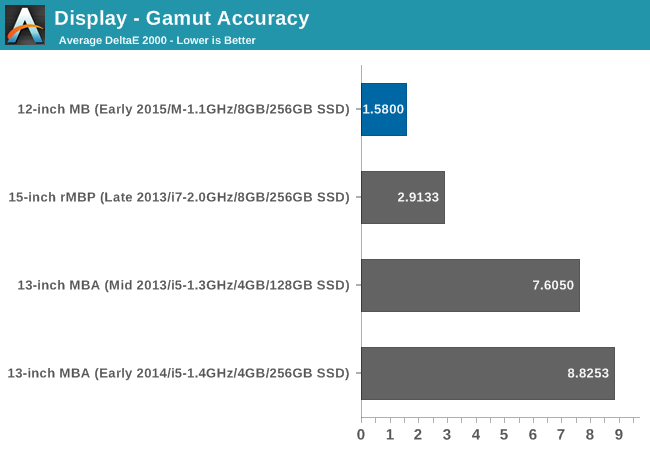
Similar to saturation accuracy, gamut accuracy is well in the MacBook’s favor. Once again even the rMBP we have on file is well behind, never mind the MBAs.
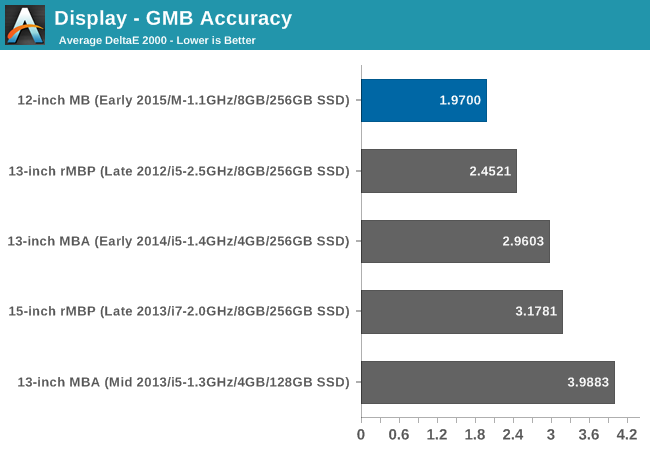
Finally, the GMB color checker results continue to be well in the MacBook’s favor. The error of 1.97 is once more better than any other Mac we have tested, and overall a great place to be at, especially for out of the box performance. Overall this reiterates the fact that while the MacBook may not be classified as a Pro, it without a doubt packs a Pro display.
With post calibration it’s almost certain we could get the errors on the MacBook down to below 1.0. But with such great out of the box performance it’s difficult to complain. Other than for color-critical work, this is a near-perfect reproduction of the sRGB color space.


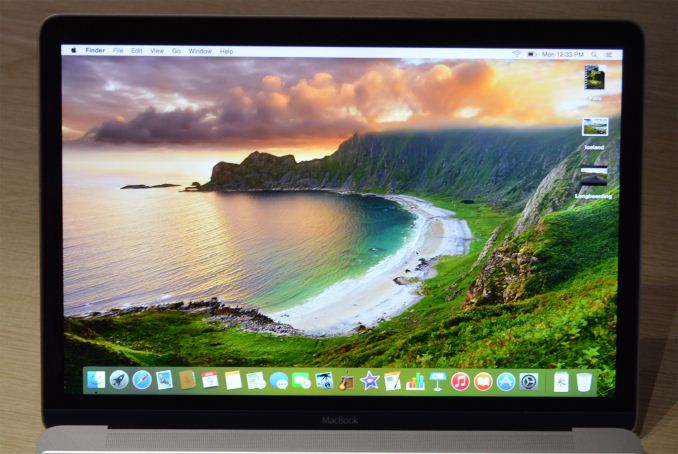
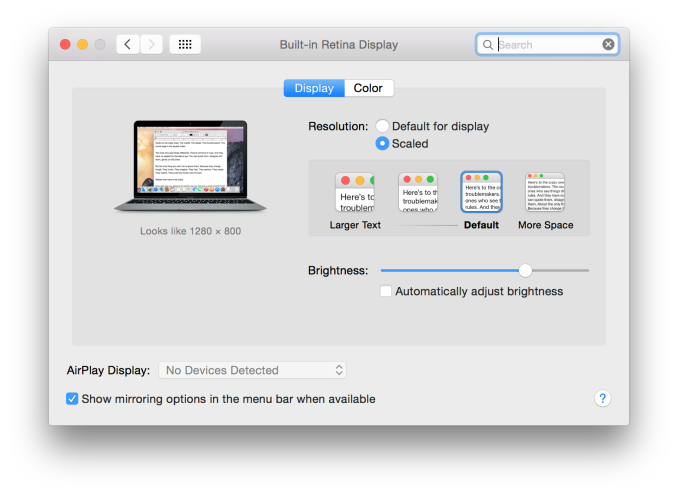
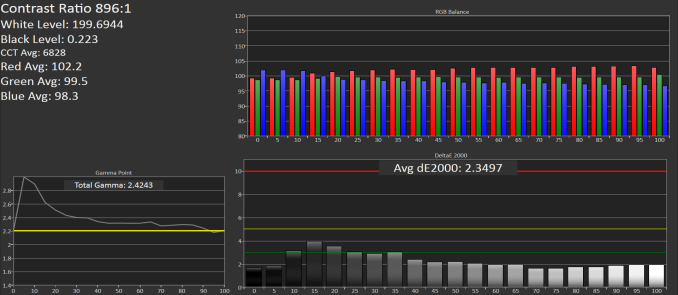
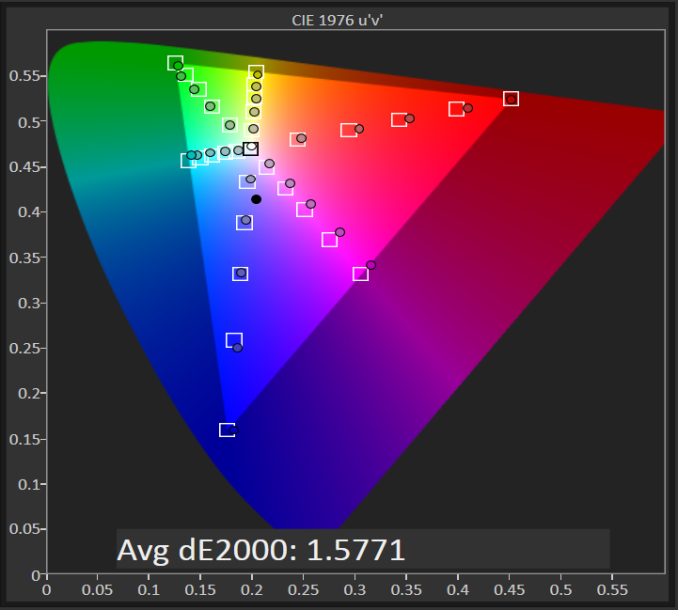










354 Comments
View All Comments
darwinosx - Tuesday, April 14, 2015 - link
If you recall back then $400 was cheap. Now you can buy a cheap Acer etc. Windows laptop for around that. But the are junk.Impulses - Tuesday, April 14, 2015 - link
$400 was cheap then? Because inflation goes in reverse? :p I don't know if you can say $400 was a small sum, I guess in relative terms you could argue most laptops were over $600... That seems like splitting hairs tho, a year or two later C2D laptops were encroaching on netbook prices and ultrabooks started looming in an effort to bring premium systems and prices into the limelight.barleyguy - Tuesday, April 21, 2015 - link
In computers, yes inflation goes in reverse. Computers have gotten more powerful and less expensive over time. The original 8086 IBM PC was $7000.MykeM - Tuesday, April 14, 2015 - link
The x7 in the Surface 3 is nowhere as powerful as the Core-M. It's even less powerful than the A8X despite having one extra core (and even less than the A8 in single core Geekbench 3 score):A8X (3 cores): 1808/4529 (single/multi)
x7-Z8700 (4 cores): 1024/3445
Core M-5Y31 (2 Cores): 2446/4615
kyuu - Tuesday, April 14, 2015 - link
FFS, please stop quoting Geekbench like it's a reliable benchmark.68k - Wednesday, April 15, 2015 - link
Amen to that!Geekbench score has some merit when comparing the same family of CPUs, like comparing one big-core Intel vs another big-core Intel. Comparing Geekbench result from different ISA seem to make little sense as the relative score is often quite far from what one see when comparing "real" programs.
Gogogoran - Wednesday, April 15, 2015 - link
I bought an eeepc 1000he as a more mobile laptop since my 15.4" at the time was becoming a pain with its lackluster battery life of 2.5 hours real life, 3.5 if I tried. I have been meaning to upgrade to a SSD and 2GB ram but I feel that would still be limiting with the low resolution screen and single core atom. Still works great after over 5 years.I'd argue that the true functional successor is the Transformer T100 and other OEM equivalents. Its cost is also on par with the original Asus eeepcs and is far more functional, even taking into account the time frame. The surface 3 I would call a premium netbook. I'm kinda more interested to see asus's transformers with the x7 when they come out. I was admittedly disappointed when the new chi line came out with the same internals as the T100 and at the top end core M. Ah well. I have a yoga pro 2 and I'm content with just about everything as my sole mobile PC now and I'm glad to not be shifting between two laptops anymore.
darwinosx - Tuesday, April 14, 2015 - link
Calling this a netbook is the easiest, laziest, and most ignorant response to make. Typically by people who have some whiny anti-apple issue.Netbooks were cheap laptops with substandard everything. Now there are even cheaper laptops with lousy displays, build quality and of course they run Windows.
PEJUman - Tuesday, April 14, 2015 - link
No Netbook from functionality standpoint is an ultra efficient, relatively low performance, severely limited IO compromise to the 2012 laptop market. From that functionality standpoint, this macbook is a netbook.Core M is still slow according to 2015 standards, the macbook still only have a single USB port. Both of this makes it a 2015 netbook, albeit a premium one, around $800ish gets you the nicer material and screen, but not functionality.
I still can't do reasonable FPS on 4K encodes with it, it still will not run my USB to CAN bus adapter. I still need a hub to run multiple USB devices, etc. The same relative feature and performance compromises between laptop-netbook still here. Both devices evolved (and our expectation should as well), in the past 3 years since netbook term was coined.
ppi - Tuesday, April 14, 2015 - link
First netbooks arrived like 8-9 years ago. iPad & tablets completely annihilated that category. Any el cheapo Android tablet can do more than Vista-powered Atom with 1GB RAM and mechanical HDD paired with 1024x800 TN panel.MacBook Core-M performance is absolutely perfect for anyone doing mostly e-mails, office, browsing. Short, burst, tasks. Doubtful you would be able to tell difference at these tasks between Core-M and i7-4790.
Obvisously, the 4.5W power envelope has its downsides - most demanding game this could reasonably run is probably something like plants vs zombies. But then you would get rewarded by great portability when running around airports.
If your performance yardstick is video encoding, anything short of full desktop is unsatisfactory anyway.